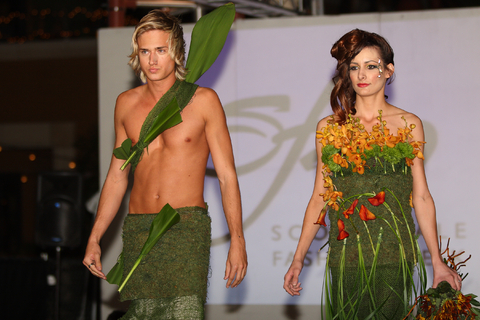Celebrity fashion. Why are we so fascinated by the subject? Whether we admit it or not, there is no denying the fact that we like to see how famous people dress. Moving pictures first made their appearance in the 1890’s. While Thomas Edison is generally credited with inventing the medium, several men were instrumental in giving birth to this process, including the brothers Lumière, who invented the first portable movie camera, and George Eastman, who created film for motion pictures.
The first movies lasted only minutes and had no sound. Nonetheless, they created a sensation. By 1910, the Eastman Company had perfected the technology of fashioning and developing vast lengths of film. Within a matter of years, going to the movies on Saturday was a part of our culture.
1916 marked the emergence of costume design in cinema. Up until that time, film actors usually supplied their own clothes, if the story was contemporary, or directors rented outfits from costume companies, if the film was a period piece.
But Parisian-born director Louis J. Gasnier had a particular “look” in mind when he was working on a movie with serial queen Pearl White. He summoned a tailor and had him assemble an outfit for the actress consisting of a black suit, white blouse, loose tie, and velour beret. The result? Secretaries of the day made this ensemble standard business dress – which it still is, in varying degrees. It was the first emergence of Hollywood celebrity fashion.
Gilbert Adrian. Orry Kelly. Edith Head. If you were alive in the 40’s, 50’s and 60’s, you probably recognize those names. If you were not, you have no doubt seen their work. For each made an indelible impression on celebrity fashion history. Gilbert Adrian, known simply as Adrian, began designing clothes for Broadway and had worked his way to MGM in Hollywood by the grand old age of 20. His ideas were fresh, innovative, and very dramatic, and helped establish MGM as the “glamour” studio, where audiences could watch and dream about a jet-set life.
His first muse was Greta Garbo, whose “Mata Hari” costumes caused a sensation in 1931. He later poured Jean Harlow into those slinky gowns that became her signature, and gave Joan Crawford the shoulder pads that started a revolution. For “Letty Lynton” (1942), he put Joan in a ruffled white organdy gown to highlight her broad shoulders, conceal her hips, and make her look taller. The result? Macy’s in New York sold 500,000 copies of the gown!
Adrian opened his own atelier in Los Angeles later that same year, and won the Coty award for fashion just two years later. He retired to Brazil in 1952 to paint landscapes.
Orry Kelly was perhaps the least likely person one would expect to design costumes. Rough looking and overweight with a penchant for booze and foul language, he nonetheless helped established Warner Brothers as the “average man’s” studio. He felt that the characters should dictate the clothes-and not the other way around. You can see his work in The Maltese Falcon (1941), Casablanca (1942) and Auntie Mame (1958).
He later shared an Oscar with Walter Plunkett and Irene Sharaff for An American In Paris (1951) and won by himself for Les Girls (1957), Some Like It Hot (1959), and Gypsy (1962).
After gowning some of Hollywood’s most glamorous women, he once summed up his career with a pithy, “Hell must be filled with beautiful women and no mirrors.”
Edith Head was arguably the most famous costume designer of them all, designing for more than 1,100 films during her 58+ year career at both Paramount and Universal studios. She gowned the likes of Elizabeth Taylor, Audrey Hepburn, Grace Kelly, and Barbara Stanwyck, and started fashion trends (stampedes?) with her sarong for Dorothy Lamour in The Jungle Princess (1936), Elizabeth Taylor’s strapless white gown from A Place in The Sun (1951) and the shoulder-tied boatneck for Audrey Hepburn in Sabrina (1954). If there ever was a celebrity fashion designer, Edith Head was it.
Walter Plunkett was the leading period costume designer in Hollywood from the 1920’s on. The man behind the clothes for Gone with the Wind (1939), Raintree County (1957), How The West Was Won (1962) and dozens of others, Plunkett arrived in Hollywood with a dream of becoming an actor. But his talent lay in costuming, as he soon discovered. He was the head of wardrobe at RKO off and on during the 1920’s and 30’s, then moved to MGM in 1945 (taking over from Adrian), where he stayed until his retirement in 1965.
The studio system began to unravel in 1948 when the major studios were forced to start selling off their theater chains as the result of an anti-trust suit. Now, unable to guarantee the distribution of their films, the studios faced uncertain futures. They went from cranking out 40 or 50 movies a year to concentrating on 12 or 15. Actors and directors became free agents, and the controlled “look” of the studio costuming gave way to the demands of the directors.
Today, few movie costumers are well known outside of the industry, and none creates a star’s signature celebrity fashion look as they once did under the studio system. With few exceptions, most contemporary costumes are bought “off the rack”, while period costumes are either made, bought or rented from costume companies.
Trends are set by individual movies now and not by costumers or stars. There are no “Joan Crawford” shoulders, for example, or “Jean Harlow” slinky dresses showing up in all a popular star’s movies. Instead, actors prefer to let their characters dictate the look of a film instead of infusing their own personality into every role they play. However, once they are off the screen, we still like to comment on their celebrity fashion looks. Just ask Joan Rivers.
Now how do you develop your own celebrity dress code? Follow these rules, and you will find success. Look at your wardrobe. See what one item you wear a lot, or seem to wear repeatedly every week, such as Skirts or Flirty Tops. Take this item and assign it for Monday, with cute high-heel shoes. For your hair, think of how you usually wear it, and wear it with Monday’s outfit. Next, pick a sporty item, like Jeans or Track/Sweat Pants. Assign that item for Tuesday, with cute sneakers like Converse. (No Nikes or Adidas- make that a rule!) Also, wear ponytails today or your hair down. Think of your favorite color. Make the assignment for Wednesday an item in your favorite color (Purple Tops, Red Belts, etc.). The hairstyle should be down. Have Thursday be the day to wear Neutral Colors like khaki, brown, earthy green and navy. Wear your ponytail half-up today. Wear Jeans, Tanks, and colored shoes on Friday. Wear a messy bun or down on Fridays. Choose casual and dressy items for Weekends, like a baggy T-shirt and jeans with an expensive designer bag. Type or write your rules in a cute font/font color and keep it secret from everyone except your two best friends.


